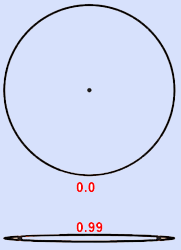This month the Earth, as it revolves around the Sun, reaches a point in its
orbit that is called perihelion. This is the minimum distance that
 separates the Earth from the Sun. Half an orbit later during the first few days of July,
the Earth is at aphelion, its maximum separation from the Sun.
This difference in distance is due to the shape of the Earth's orbit being elliptical rather than circular.
However the Earth has only a mildly elliptically-shaped orbit that is actually closer to being
slightly out-of-round than the incorrect, very elliptical orbit that is shown here as well as in
most textbooks. A result of this incorrect depiction of the shape of the Earth's orbit
is that many have a mental image of the Earth in an oval-shaped orbit around the Sun.
separates the Earth from the Sun. Half an orbit later during the first few days of July,
the Earth is at aphelion, its maximum separation from the Sun.
This difference in distance is due to the shape of the Earth's orbit being elliptical rather than circular.
However the Earth has only a mildly elliptically-shaped orbit that is actually closer to being
slightly out-of-round than the incorrect, very elliptical orbit that is shown here as well as in
most textbooks. A result of this incorrect depiction of the shape of the Earth's orbit
is that many have a mental image of the Earth in an oval-shaped orbit around the Sun.
Orbits Are A Bit Eccentric

When the shape of a planet's orbit is being discussed it is worthwhile to consider
the work done by Johannes Kepler using Tycho Brahe's observational data.
Kepler's first law described the shape of the orbit as being elliptical rather
than circular. While a circle has one focus, the center point, an ellipse has two,
called foci. The Sun is at one focus of a planet's elliptical orbit while there
is empty space at the other. The distance between the center point of a circle
and the circle line surrounding it is known as the radius. A planet following
an elliptical orbit has an average distance from the focus (Sun) known as the
semi-major axis. The semi-major axis is half of the length of the long axis of an
ellipse.
| Planet |
Eccentricity |
| Mercury |
0.2056 |
| Venus |
0.0067 |
| Earth |
0.0167 |
| Mars |
0.0935 |
| Jupiter |
0.0489 |
| Saturn |
0.0565 |
| Uranus |
0.0457 |
| Neptune |
0.0113 |
| Pluto |
0.2444 |
When describing these shapes the term eccentricity is used. A scale of
0 to 1 is used where a circle has an eccentricity of 0. The Earth's orbit is
only slightly elliptical with an orbital eccentricity of only 0.0167.
On 4 July 2011 the Earth will be 152 102 140 km from the Sun. This month,
when the Earth is closest to the Sun, the distance
separating them is about 147 105 721 km. This is a difference of only about 5 000 000
km between perihelion and aphelion. That's not much when you consider that the
diameter or Earth's orbit is about 300 000 000 km.